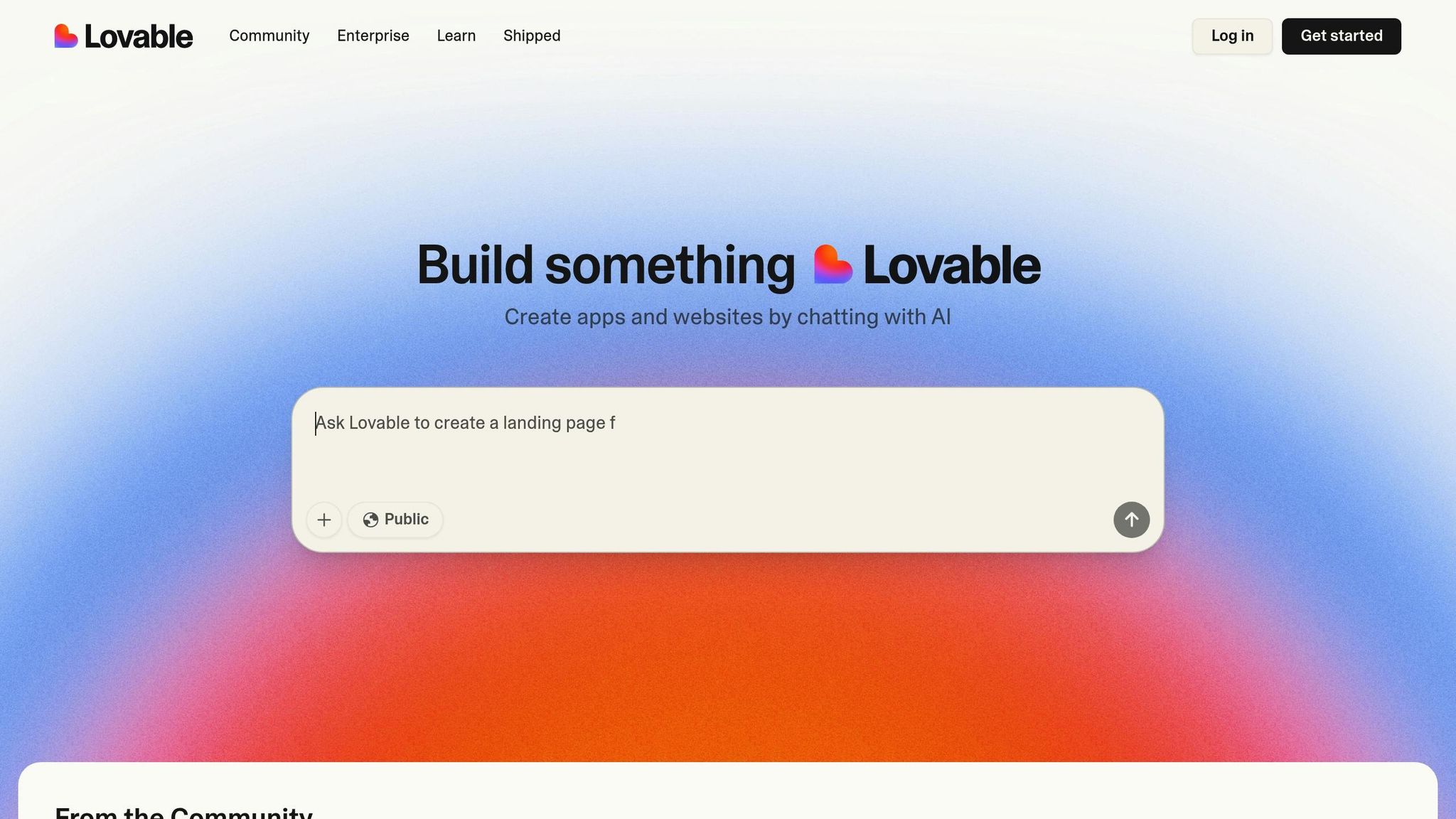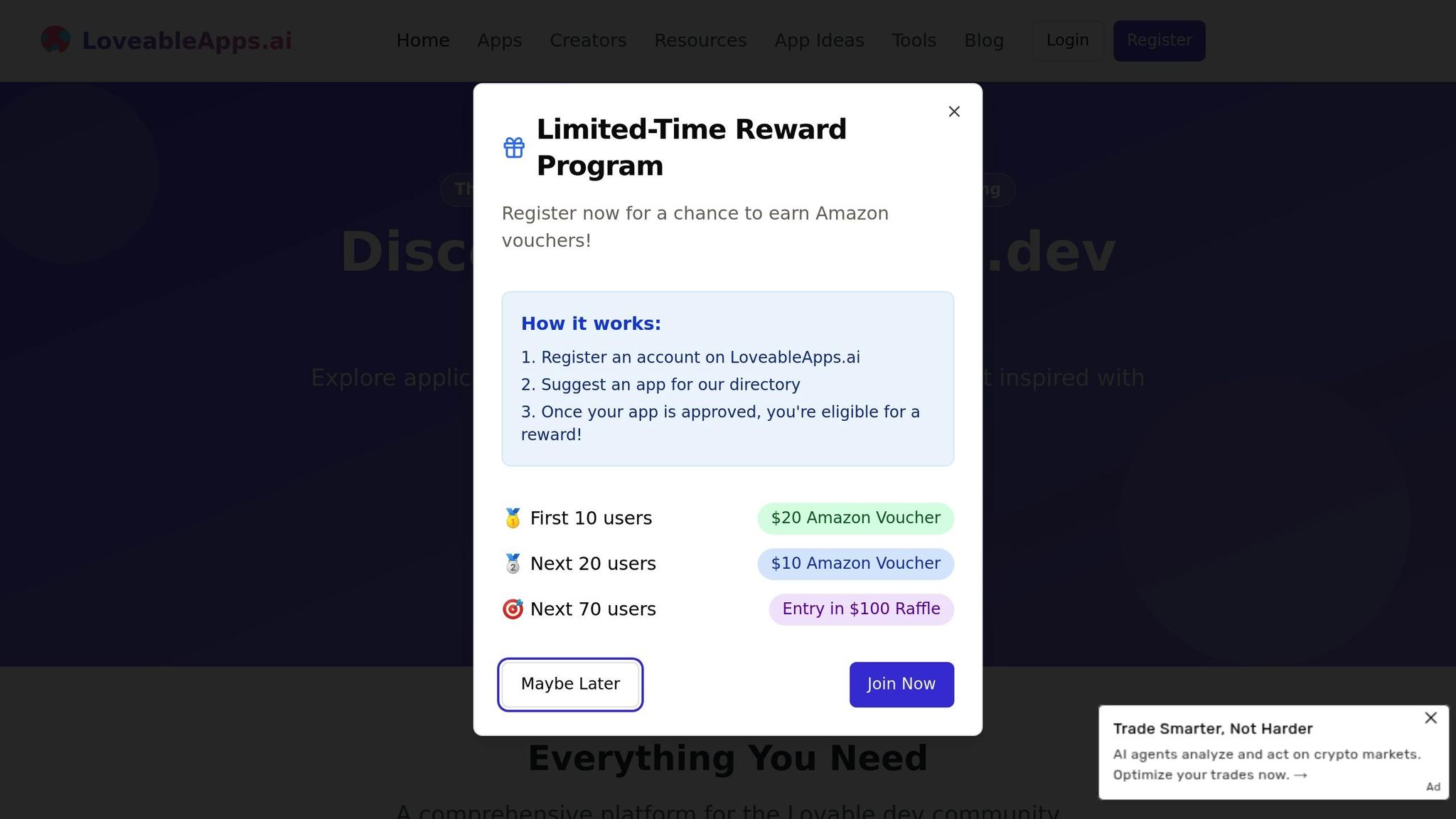Case Study: Iterating a Lovable.dev App for Better UX
Learn how iterative design and user feedback transformed a freelance project management app into a user-friendly tool, achieving significant improvements.

Iterating your app is the key to creating a better user experience. This case study highlights how Sarah Chen, a solo entrepreneur, used Lovable.dev to transform her app, TaskFlow, from a basic prototype into a user-friendly tool for freelancers. By leveraging Lovable.dev’s AI-powered tools, she quickly built, tested, and improved her app based on feedback, all within a few months.
Key takeaways:
- Rapid Prototyping: Sarah created a functional prototype in just two weeks using Lovable.dev’s natural language interface.
- User Feedback: Usability testing revealed issues like confusing automation features and backend errors.
- Improvements: Lovable.dev’s tools helped Sarah fix bugs, refine workflows, and enhance the app’s design.
- Results: TaskFlow saw a 30% drop in user errors and improved task completion rates.
This case study demonstrates how small teams or solo creators can refine their apps efficiently with the right tools. Lovable.dev empowers developers to focus on user needs, iterate quickly, and deliver polished results.
Project Background: Building the First Version
App Concept and Goals
TaskFlow began as Sarah Chen's solution to a common problem she faced as a freelance graphic designer: juggling multiple projects while staying organized. She envisioned an app that could help independent professionals like herself track project milestones, manage client communication, and organize deliverables - focusing only on the features that truly mattered.
The app was designed specifically for freelancers and solo professionals in creative fields who needed simple, effective project management without the overwhelming complexity of enterprise tools. Sarah wasn’t interested in creating just another generic app. Instead, she wanted to tackle the inefficiencies that existing tools often overlooked. Her vision for TaskFlow was a centralized platform offering clear workload insights, realistic timelines, and streamlined client updates - all without endless back-and-forth emails.
Her initial goals were straightforward yet ambitious. She aimed to launch a minimum viable product (MVP) within a month, test it with 50 freelancers from her network, and refine the app based on their feedback. The objective was to make TaskFlow easy enough for busy professionals to adopt immediately, while still robust enough to replace their current mix of tools.
Using Lovable.dev for the First Build

While exploring no-code solutions, Sarah came across Lovable.dev, a platform designed to help users build functional web apps using natural language. With her strong design background but limited coding skills, Lovable.dev's promise of turning written descriptions into working apps instantly caught her attention.
"dropping the barrier to entry to build products was the goal" - Anton Osika, Lovable's Founder
This philosophy aligned perfectly with Sarah’s needs. She started by describing her app’s features in plain English: “I need a dashboard that shows all active projects, a calendar view for deadlines, and a simple way to upload and organize files for each client.” Lovable.dev’s AI-powered interface transformed these descriptions into actual app components, allowing her to see her ideas come to life in real-time.
The development process was faster than Sarah had expected. Within just two weeks, she had a fully functional prototype that included user authentication, project workflows, file uploads, and basic client communication tools. Lovable.dev’s visual interface made it simple to tweak layouts, adjust colors, and refine user interactions - all without writing a single line of code.
What stood out most to Sarah was how Lovable.dev handled the technical aspects she couldn’t manage herself. From database connections to user permissions and responsive design, everything worked seamlessly in the background. This freed her to focus entirely on perfecting the user experience, laying the groundwork for usability testing and future improvements.
Why Iterative Design Process Brings the Finest Results
Usability Testing: Finding the Problems
After rolling out the first version of TaskFlow, user testing became a critical step in assessing the app’s usability and pinpointing areas that needed improvement.
Testing Methods Used
To gather insights, Sarah relied on a mix of tools, each designed to tackle specific aspects of user behavior and feedback. Here’s a quick breakdown of the tools she used and their standout features:
| Tool | Starting Price | Best For | Key Feature |
|---|---|---|---|
| Maze | $75/month (free plan) | Continuous discovery | Unmoderated usability testing |
| Hotjar | $32/month | Behavior analytics | Heatmaps and session recordings |
| Lyssna | $75/month (free for short tests) | Quick validation | First-click studies |
| Userfeel | $60/credit | Targeted research | User recordings |
| UXtweak | €99/month (free plan) | Multi-method research | Card sorting, tree testing, prototypes |
These tools didn’t just collect data - they provided a clear view of where the app was falling short, offering actionable insights into user behavior and pain points.
Main Issues Found
The testing process brought several significant problems to light that required immediate attention. Two major issues stood out:
-
Data quality problems: Users encountered nonsensical automation suggestions. For example, some automations were incorrectly labeled, like "notifying new Twitter followers" being listed as a Slack capability. This echoed challenges seen in other AI app builders:
"The data quality issues became apparent, with some nonsensical automation 'abilities' showing up (like 'notifying new Twitter followers' listed as a Slack capability)" – Tom Nassr and Matt Jasinski, XRay.Tech
- Incomplete automation features: TaskFlow was operating at only 60–70% of its expected efficiency. It was clear that the app needed more refinement before it could be considered a polished product.
These findings underscored the importance of addressing core usability issues before venturing into expanding the app’s functionality.
Making Improvements: From Feedback to Fixes
With clear insights from user testing in hand, Sarah set out to transform TaskFlow from a struggling app into a polished, user-friendly product. The feedback highlighted two pressing problems: backend issues causing incorrect automation displays and incomplete automation features that left users frustrated. These challenges became the foundation for focused improvements in both user experience and performance.
UX Changes and Design Updates
To address confusing automation suggestions, Sarah turned to Lovable.dev's Chat Mode and Visual Edits tools. Chat Mode's AI analyzed logs and database queries, pinpointing the root causes of mislabeling in automations. Meanwhile, the Visual Edits tool offered a Figma-like interface, allowing Sarah to directly make and preview changes in real-time. She revamped the main dashboard using client-side Tailwind generation, ensuring the navigation emphasized the most frequently used automation types identified during user testing. This approach streamlined the user experience and made the app more intuitive for its audience.
Performance and Feature Updates
On the performance front, Sarah focused on completing the missing automation features and resolving backend issues. She leveraged Lovable.dev's Supabase integration for authentication, storage, file handling, and analytics - key components in fixing automation errors and improving system reliability. When API issues arose, the AI-driven debugging tool's "Try to Fix" button proved invaluable, enabling quick resolutions. Additionally, Sarah refined database queries using Lovable.dev's AI-powered Retrieval-Augmented Generation, which significantly boosted TaskFlow's functionality from 60–70% to over 90%.
Using Lovable.dev for Quick Changes
Lovable.dev became Sarah's secret weapon for rapid progress. Tasks that would typically take weeks were completed in days. The platform's tools allowed her to prioritize planning - spending 80% of her time refining her vision in Chat Mode before diving into implementation. This strategic approach made her prompts more effective, reducing the number of iterations needed to achieve her goals. As Stephane from Lovable.dev put it:
"The difference between getting a mediocre response and having AI build entire workflows for you comes down to how you prompt."
Collaboration was another area where Lovable.dev excelled. Its workspace feature enabled Sarah to work seamlessly with a designer in real time. When bugs surfaced, she followed a systematic debugging process: starting with the "Try to Fix" button, providing detailed bug reports with images, and reverting to earlier stable versions if necessary.
Results and Key Takeaways
Impact of UX Changes
TaskFlow's transformation highlights how targeted updates can lead to significant improvements in user engagement. By redesigning the dashboard and strengthening the backend, the platform delivered a smoother, more intuitive experience. The integration with Supabase played a key role, resolving backend issues and ensuring a seamless workflow.
Sarah's success reflects the broader potential within the Lovable.dev ecosystem. One standout example is an independent creator who developed a $30,000 app in just 10 days using Lovable.dev. This underscores the platform's ability to empower creators to iterate quickly and bring innovative ideas to life. These outcomes offer valuable insights and strategies for indie makers.
Lessons for Indie Makers and Small Teams
Several important lessons emerged from these improvements. For instance, strategic planning - such as refining prompts in Chat Mode - helped reduce iteration cycles while producing better AI-driven solutions. Breaking large tasks into smaller, manageable steps also proved effective. Sarah's approach of addressing backend challenges first before focusing on front-end enhancements showcases the value of tackling issues systematically.
Lovable.dev’s built-in integrations, like Supabase for authentication, storage, and analytics, eliminated the need to build these systems from scratch. This freed up time and resources to focus on improving the user experience. Additionally, the platform’s collaborative workspace features enabled real-time teamwork, even for small teams without extensive development resources.
How LoveableApps.ai Supports Builders

LoveableApps.ai functions as a central hub for Lovable.dev creators, offering tools and resources to support their projects. It includes an app directory, creator showcases, and tutorials specifically tailored to Lovable.dev development. The creator showcase connects builders with experienced developers, encouraging collaboration and knowledge sharing.
These resources address critical areas like prompt engineering, UX design fundamentals, and architectural best practices, helping creators avoid common pitfalls during the early stages of development. The community-driven nature of LoveableApps.ai ensures that indie makers and small teams can learn from one another, building on proven strategies to achieve success within the ecosystem.
"I built a $30k app with AI in just 10 days using Lovable.dev. As someone with minimal coding experience, the platform's AI capabilities and integrations made the process seamless."
– Independent Creator, lumberjack.so
Conclusion: Iteration Leads to Better Apps
Sarah's journey with TaskFlow shows how consistent iteration can transform an app's performance. Through focused usability testing and step-by-step improvements, she achieved a 30% drop in user errors and significantly higher task completion rates. These results highlight a universal truth: no app launches perfectly, but the best ones evolve over time.
Platforms like Lovable.dev make this evolution easier. With its rapid feedback tools, Sarah could test updates without disrupting the live app. This streamlined process eliminates many of the challenges that often hold indie developers back from conducting thorough testing.
For developers working with tight budgets or small teams, feedback isn't just helpful - it's essential. By breaking improvements into smaller, actionable steps, Sarah created a clear path forward. This approach is a game-changer for teams who need to make every development hour count.
Adding to these strategies, LoveableApps.ai provides valuable resources for developers. Its app directory offers real-world examples of successful Lovable.dev projects, while its creator showcase connects makers with seasoned developers. This kind of collaboration and knowledge-sharing accelerates the improvement process.
As no-code and low-code platforms continue to open doors for more creators, the ability to iterate quickly becomes a critical edge. Teams that embrace the cycle of building, testing, learning, and refining can adapt to user needs and market shifts faster than ever.
TaskFlow's transformation underscores that great apps are the result of thoughtful iteration. By leveraging Lovable.dev's tools and LoveableApps.ai's community resources, developers can achieve polished, professional outcomes without the usual overhead of traditional development.
The takeaway for aspiring app builders? Build, test, improve - repeat. Every user insight is a stepping stone toward a better product. With the right mindset and tools, iteration isn't just a process; it's the key to creating apps that genuinely serve their users, from concept to completion.
FAQs
How did Sarah Chen solve TaskFlow's data quality and automation challenges using Lovable.dev?
Sarah Chen used Lovable.dev to create advanced AI agents that revolutionized TaskFlow's workflows. These agents took over repetitive tasks, improved data accuracy, and streamlined automation processes, leading to better lead qualification and boosting overall business performance.
By actively incorporating user feedback, Sarah fine-tuned her app to deliver a smooth and user-friendly experience, highlighting the versatility and potential of the Lovable.dev platform.
How did Lovable.dev help Sarah enhance the user experience of TaskFlow?
Lovable.dev equipped Sarah with tools that made refining TaskFlow’s user experience faster and more effective. With its rapid prototyping features, she could swiftly design and test fresh ideas. The platform’s AI-driven suggestions provided smart recommendations to enhance usability, while its smooth iteration workflows allowed her to implement updates and collect feedback effortlessly. This setup ensured ongoing improvements without unnecessary holdups.
What can indie makers and small teams learn from Sarah's process of improving TaskFlow with Lovable.dev?
Indie makers and small teams can learn a lot from Sarah's method of improving TaskFlow with Lovable.dev. Her strategy underscores the value of quick iterations and gathering real feedback from users to fine-tune the app's user experience.
Using Lovable.dev's low-code tools, Sarah made swift updates without diving into complex coding, saving both time and effort. This approach shows how staying attuned to user needs and focusing on iterative development can lead to apps that feel more intuitive and user-friendly. Lovable.dev equips creators with the tools to build, test, and refine apps more efficiently, encouraging innovation and solutions shaped by community input.



